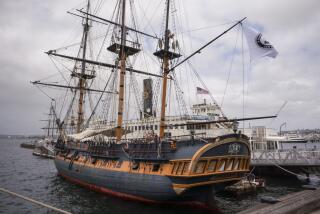A 150-Foot Yacht? That’s a Rowboat These Days
FORT LAUDERDALE, Fla. — In days of yore, there were only yachts.
Sleek and noble, the 40-foot sea chariots served as symbols of opulence, style and refinement in America -- the ultimate playthings for the ultimate few.
Until superyachts.
Twice as large as their predecessors, with mid-ocean necessities such as spiral staircases, split-level saloons and flybridge hot tubs, these floating mansions eclipsed conventional yachts.
Then along came megayachts.
These Poseidons possessed not only grandeur (nobody dared describe a yacht less than 150 feet as a “mega”), but touches of lavishness that tickled the imaginations of Arab sultans and American tycoons.
They had crystal elevators, goatskin walls. They had aft-garages that fit fleets of Rolls-Royces and gyroscopically controlled swimming pools -- to keep the water smooth in the most turbulent of seas.
By the late ‘90s, however, there was talk that the megayacht’s reign was ending. Truly, some yacht-hoppers wondered, why would a gazillionaire suffer the indignity of cruising through a soup of 35-footers aboard a vessel only five times bigger?
It so happens they were right: Ever bigger yachts are rolling out of shipyards, replacing jets and palaces and Jaguars as the premier demonstration of wealth among the world’s superrich.
Consider:
* The largest privately owned boat now spans 525 feet.
* In yachting terminology, “fully loaded” means boats with on-board helicopters, submarines, full-size movie theaters, missile-detection systems, 18-hole golf courses.
* Rafts are stowed nowadays on dingys, which in turn are kept on 36-foot tenders, which in turn sit in the belly of the main yacht -- essentially, a boat in a boat in a boat.
The “grow, grow, grow your boat” craze has shipbuilders, brokers and marine architects in a tizzy, as it does most boat enthusiasts in this seaside city, which bills itself as the yachting capital of the world.
Frank Herhold, executive director of the Marine Industries Assn. of South Florida, is ecstatic. Still, the expansion of yachts over the past six years has created a quandary.
“It would be appropriate to coin a new name for these boats,” Herhold says. “ ... If you own a yacht that’s 400 feet long -- well, that’s in a class by itself.”
On the docks, in the shipyards, a new name is already surfacing.
The gigayacht.
*
At this year’s cruise-industry convention in Miami, Barry Gilmour, chairman of Oceanic Investment Corp., had some news for his fellow shipbuilders: His company had designed, on paper, a 630-foot yacht -- a private vessel longer than two football fields.
When eyebrows went up, Gilmour told his colleagues, “Somebody will order one of those, take it from me.”
That Gilmour was even talking yachts at a gathering of cruise shippers was news; never had the Seatrade Cruise Shipping Convention included a symposium on anything as puny as a yacht.
It made perfect sense to Capt. Tom Thomason, director of shipbuilding for Carnival cruise line. Except for passenger capacity, he said, “between the largest yachts and the average cruise ships, there’s not a whole lot of difference.”
Clearly, the gigayacht is rocking the boat industry.
Though accounting for a relatively small slice of yacht orders, yachts of mega and giga proportions are being built as never before. This year, 651 are under construction, up from 507 last year and 482 in 2003 -- a nearly $1 billion increase in sales, industry experts say.
A third of the yachts listed on the World’s Top 100 by Power & Motoryacht magazine were built after 2000; of the top 40 under construction, the average length is 241 feet.
Americans, the world leaders in the purchase and charter of big yachts, are largely driving that demand, says Jim Eden, who has been brokering yachts for 35 years. He works at the venerable International Yacht Collection in Fort Lauderdale.
“The bread-and-butter boats used to be 30, 35 feet long,” Eden says. “Now, it’s hard to get my bosses interested in brokering a yacht under 70.”
He attributes the boom to the growing number of dot-com and telecom billionaires, and to the Bush administration’s tax breaks for America’s wealthiest. Equally important, he says, is a sea change in attitude among America’s superrich after Sept. 11, 2001.
“Clients are telling me, ‘Hey, I could have been in the Twin Towers. That could have been me jumping out a window.’ The thinking among wealthy people now is, you can die anytime. Nobody can protect you. So you might as well spend your money now and enjoy it.”
The gigaboom has caught a number of people by surprise, among them Chris Taylor, vice president of International Yachtmaster Training, a school for yachtsmen and crew in Fort Lauderdale.
This year, Taylor estimates a worldwide shortage of crew on the order of 3,000 deckhands, bosuns, mates, captains, engineers, stewardesses and chefs. “We’re the biggest yacht-training institution in the world and we cannot find enough qualified crew. It’s enough to blow your mind.”
Eden, the yacht broker, is hardly fazed.
He explains: “The Fortunate 4,000 of this world just want to take their family and friends to places that ordinary people like you and me can’t go. They want to be able to go off to Alaska, or to the Galapagos Islands, on their own yacht -- and do it in style.”
*
In the race to build the world’s yachts, the United States places second to Italy among the world’s Top 10 “yacht-builder nations.” (Twenty-two American manufacturers are turning out 5.2 miles of yachts.) The Netherlands runs a close third.
German shipbuilders, however, are at the forefront of the gigayacht revolution.
Lurssen, of Bremen, Germany, is the quintessential gigabuilder. The average length of its creations is 277 feet -- 51 feet longer than its closest competitor, according to the Global Build Report, published by Yachts International Magazine. (The total length of Lurssen yachts being built for U.S. clients alone exceeds the height of the Empire State Building.)
It builds boats like Octopus -- the $250-million aqua-palace of Paul Allen, co-founder of Microsoft.
With a crew of 60 that includes former Navy Seals, the 414-foot Octopus became, on its 2003 maiden voyage, the world’s largest, priciest, privately owned yacht.
Octopus has seven decks. It has two helicopter landing pads. It has a swimming pool, basketball court, infirmary, a garage for Land Rovers, a movie theater, a concert space for 260, and a recording studio. (It has reportedly become a home away from home for Robbie Robertson, the rock star.)
Octopus also features an underwater viewing salon -- with a glass bottom and stadium-strength lighting -- to allow passengers to gaze for hours at sea varmints. (The engineer also suggested adding torpedo launchers for added security, but Allen considered that excessive.)
All great yachtsmen have great rivals, though, and Allen was soon to be out-giga-d by Larry Ellison, titan of Oracle, the California software firm.
At the time Octopus was launched, Lurssen was secretly crafting Ellison’s “Rising Sun,” a 393-foot behemoth that the owner would later describe as a “sculpture made of metal and glass.”
But when it became apparent that Octopus was 21 feet longer than his yacht, Ellison ordered the German shipbuilder to extend Rising Sun to 452 feet -- thereby wresting the title from Allen.
Upon completion, Ellison’s floating skyscraper had five stories, 82 rooms, a wine cellar the size of most beach bungalows, a dozen yacht-length tenders, and a generator capable of providing enough electricity for a small town in Maine.
Rising Sun was outfitted with a $50,000 satellite, radar systems with “intelligent” anti-collision warning features, and anchor stabilizers -- great fins that tricked the waves and kept the monolith from rocking.
Final cost: $377 million.
*
In addition to luxury and size, the gigayachtsman frequently yearns for toys on the high seas -- the extras that personalize a gigayacht, make a sea voyage more memorable.
Helicopters, Jet Skis, speedboats, torpedoes and submarines populate the giga-toy chest. (Octopus, for example, carries a sub capable of taking 10 passengers on a two-week dive.)
Other playthings:
* Saudi billionaire Nassar al-Rashid keeps a sand beach on the deck of his 344-foot “Lady Moura.”
* New Zealand telecommunications mogul Alan Gibbs, 65, often drops the anchor of his $40-million boat, “Senses,” so that he can launch a sports car that transforms itself into a speedboat, a la Agent 007.
* Russian oil tycoon Roman Abramovich has outfitted his 375-foot “Pelorus” with bulletproof transoms, a missile-detection system, two helicopters, a submarine and “paparazzi lights” -- to obliterate the film of pesky photographers from several hundred yards.
Yet the limits of extravagance are far from being reached.
In April, the Lurssen yard rolled out its latest masterpiece: a 525-footer for Sheik Mohammed bin Rashid Maktoum, the Crown Prince of Dubai. “Platinum,” with two master staterooms, a 70-foot-wide atrium, cinema, disco, gym, squash court, submarine and helipad, topped Rising Sun by 73 feet -- thereby becoming the biggest of the big boats.
For now.
Is that a terayacht looming, eclipsing the sun?
More to Read
Sign up for The Wild
We’ll help you find the best places to hike, bike and run, as well as the perfect silent spots for meditation and yoga.
You may occasionally receive promotional content from the Los Angeles Times.






